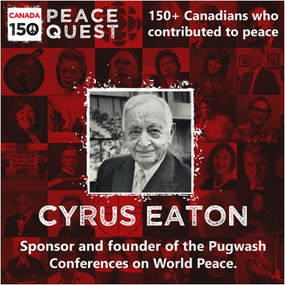| Audio of Cyrus Eaton Bio read by Cathy Eaton |
Cyrus Eaton was born on December 27, 1883, not far from here in Pugwash River, Nova Scotia. He was my grandfather.
He became a wealthy industrialist, a generous philanthropist, and a passionate advocate for peace between communist and capitalist countries. In the 1950s and 1960s, he hosted and funded the early Pugwash Conferences on Science and World Affairs in his hometown of Pugwash, Nova Scotia and in other locations. In 1995, the Nobel Peace Prize was awarded jointly to the Pugwash conferences and Joseph Rotblat.
Joseph Howe Eaton, Cyrus’s father, eventually owned three farms, a general store, and ran the local post office as well as a lumber business. However, in the early years, the family owned one farm and barely had the funds to pay one hired man. Cyrus’s mother, Mary Adelia MacPherson, was a devout Baptist who encouraged her son to study for the ministry and to read widely in literature, history, religion and philosophy. Before Cyrus was born, the couple lost four children to diphtheria. Three sisters and a younger brother were born after him.
As a four-year-old, his father trusted Cyrus, the oldest surviving child, to drive a horse and wagon to Conns Mills in order to have the flour ground for his mother to bake bread. Cyrus, who weighed out flour, sugar and raisins, and counted change carefully, often waited upon customers in Joseph Eaton’s general store. His father used to boast, “When Cyrus was six, I could leave him in the store for hours alone and he never failed my confidence. His qualifications for big business are brains and absolute trustworthiness.” The family moved to Pugwash Junction.
His father also inadvertently provided his son with international reading material since one of his jobs at the post office was to sort newspapers from Boston, Providence and Halifax. Cyrus recalled, “By the time I was ten, I was pretty well experienced in business and world affairs – my father was postmaster and I used to read all the newspapers that came in to subscribers.”11
Cyrus, following in the path of his Uncle Charles Eaton just fifteen years older, attended a one-room schoolhouse under the instruction of Margaret King in Pugwash Junction, before studying at Amherst Academy in Amherst. For being top of his class in science, Cyrus was presented at graduation with complete works of Charles Darwin and Thomas Huxley, along with framed photographs of the authors, which now hang in the Cyrus Eaton room at Thinkers Lodge. The evolutionist and the biologist undoubtedly sparked his interest in science and his desire to nurture the environment and prevent it from being irrevocably destroyed by atomic weapons.

 RSS Feed
RSS Feed